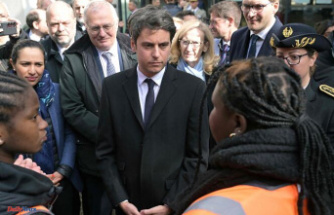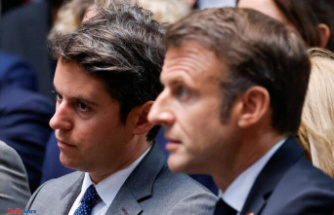A plateau develops during the summer wave, the next autumn and winter wave is already rolling in. Health Minister Lauterbach and Justice Minister Buschmann will present their measures for the Corona winter on Wednesday. All questions and answers at a glance.
What is coming to Germany in the Corona autumn?
As soon as he announced the agreement with Justice Minister Marco Buschmann, Health Minister Karl Lauterbach said he was expecting a "very difficult autumn". The SPD politician explained that even those who were vaccinated four times with the previous vaccines only had an infection protection of less than 40 percent compared to the omicron variant BA.5. He fears that critical infrastructure and hospitals could be overloaded. FDP Minister Buschmann emphasized that the following also applies in autumn and winter: "There may only be restrictions on freedom if they are necessary." But even without a new "killer variant" it could be difficult.
What is the current Corona situation like?
The summer wave that is still rolling has brought many hospitals to their breaking point again. According to the DIVI intensive care register, around 2900 intensive care beds are currently free, at the peak of the omicron wave in late March there were just over 3000. Lauterbach himself recently described the situation as a candle that burns at both ends: above the (too many) patients, below the (too few) staff.
The actual corona situation has calmed down again slightly. After the seven-day incidence has been climbing for weeks since the end of May, it has been falling for a few weeks. The Robert Koch Institute (RKI) reported the value at 451.3 for today, Thursday. The number is only meaningful to a limited extent: not all infected people also do a PCR test and thus appear in the statistics. Another indication of a high number of unreported cases is the proportion of positive tests - in the past week it was 54.1 percent.
But even if the incidence has recently fallen again, the RKI does not give the all-clear. "Furthermore, a sideways movement rather than a downward trend can be observed," said the weekly report last Thursday. The incidence has continued to rise, particularly among at-risk people over the age of 80. Outbreaks in nursing homes have also increased. According to the RKI, the number of deaths has leveled off at 400 people a day.
What exactly does the draft say?
With the approval of the Bundesrat and Bundestag, the amended Infection Protection Act could be passed as early as September. Then the "winter tires" principle should be used. For the period from October to Easter (beginning of April 2023), not only are the winter tires taken out of the basement, but also the Corona rules.
Basically, this means no lockdowns and curfews. The draft by Lauterbach and Buschmann provides for some nationwide rules, such as an FFP2 mask requirement in long-distance transport. In addition, there should be an FFP2 mask and test obligation in hospitals and care facilities. Those who were infected or vaccinated more than three months ago must test themselves. In addition, companies should provide opportunities for working from home or for testing in the company. According to the Buschmann-Lauterbach paper, school closures are also off the table. Mask requirements should only exist from the fifth grade.
And, to stay with the metaphor, each federal state can choose its own "winter tire" model. Optionally, masks may be compulsory on buses and trains or in publicly accessible indoor areas. Mask requirements in restaurants or the leisure area are also possible - alternatively, a test is also possible if the last infection or vaccination was less than three months ago. If the critical infrastructure is in danger, the federal states can also apply the "snow chains" by state parliament resolution. Means: FFP2 mask requirement in gastronomy and outdoor events as well as hygiene concepts, distance requirements and upper limits for persons at events.
Which criteria should decide?
Since the seven-day incidence has only limited significance, the federal government wants to use other indicators. This also includes the weekly survey of the positive rate for the PCR tests, the hospitalization incidence, i.e. the number of corona patients in the intensive care units and the wastewater monitoring. This is intended to detect larger outbreaks at an early stage.
Is there criticism?
Yes. Especially on a rule. According to the Lauterbach-Buschmann paper, in the catering and leisure sector, those who were vaccinated or infected no more than three months ago are exempt from the test and FFP2 mask requirement. Critics say that this would indirectly exert pressure to be vaccinated every three months - without the Standing Vaccination Commission (STIKO) having recommended a fourth vaccination for under 70-year-olds.
The president of the teachers' association, Heinz-Peter Meidinger, criticized the fact that masks can only be compulsory from the fifth grade. Without masks, school closures or class cancellations at primary schools would be more likely. The German Medical Association, on the other hand, complained that the protection concept was “unfortunately still vague” in some places. It is unclear, for example, what should happen if there is a risk of the medical infrastructure being overloaded.
Concerns about a patchwork quilt, as there was in earlier Corona phases, were also criticized. Because the states still have a lot of leeway, there could also be 16 different interpretations of the phased plan. Minister of Health Lauterbach replied to “RTL Direkt”: “I don’t hope that there will be a patchwork quilt, we are working with the countries to use the maximum that we offer.”
And from a virological point of view? Is that enough?
That is the question. According to the Bonn virologist Hendrik Streeck, it is unclear how the many infections in summer and the associated immunity will affect the winter wave. The virologist Martin Stürmer sees this much more critically. "We could be well prepared if we weren't faced with a completely new variant," he told NDR. Many people have already been infected with the BA.5 variant, who will then not fall ill again in autumn and winter. If no new variant came up, the draft measures would be relatively easy to get through, says Stürmer. "But we can't assume that."
Rather, it must be assumed that the virus will provide a new variant. Then the law is not enough. The virologist explains this using the vulnerable groups. They moved not only in hospitals and nursing homes, but also in everyday life. "The responsibility is shifted to the states, with very unclear criteria."
Buschmann or Lauterbach, who actually prevailed?
They struggled for a long time, and in the end it was a clear draw. FDP Minister Buschmann was able to announce that there are no curfews and lockdowns. On the other hand, SPD Minister Lauterbach was able to announce a far-reaching mask requirement. In addition, he was able to push through further vaccination incentives without 2G and 3G regulations. Because anyone who has been vaccinated with the adapted Omikron vaccine can waive the obligation to test in some places. How this works in practice remains to be seen. (You can read here for whom the fourth vaccination makes sense.)
What if the winter wave turns out to be much worse than expected?
The Bundestag then still has the opportunity to determine the epidemic emergency of national importance. This would also give the federal government much stricter measures, such as new contact restrictions. The rules announced by Buschmann and Lauterbach should apply regardless of this.












